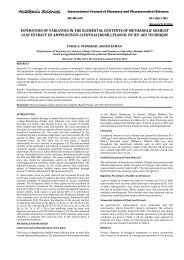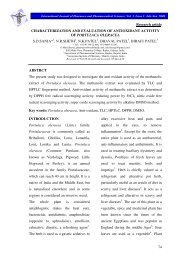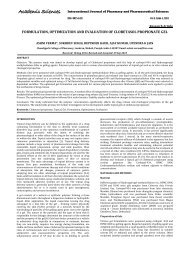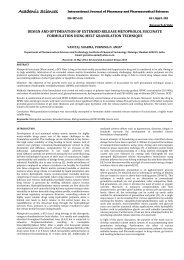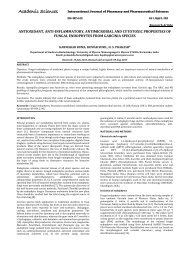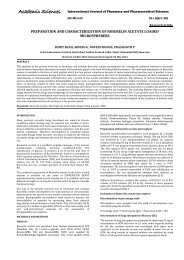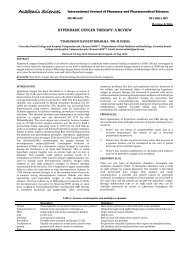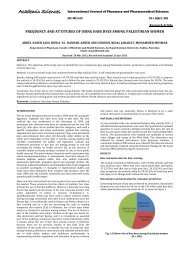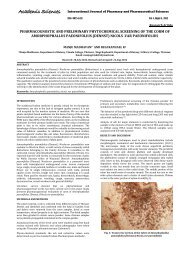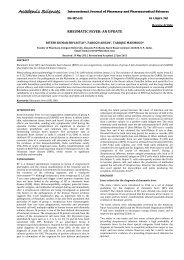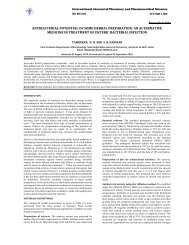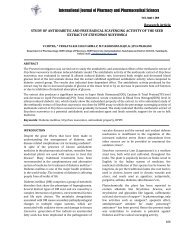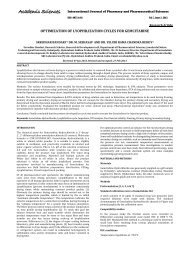formulation aspects in the development of orodispersible tablets
formulation aspects in the development of orodispersible tablets
formulation aspects in the development of orodispersible tablets
Create successful ePaper yourself
Turn your PDF publications into a flip-book with our unique Google optimized e-Paper software.
Review Article<br />
FORMULATION ASPECTS IN THE DEVELOPMENT OF ORODISPERSIBLE TABLETS: AN<br />
OVERVIEW<br />
TAPAN KUMAR GIRI 1* , DULAL KRISHNA TRIPATHI 1 AND RANA MAJUMDAR 2<br />
1Rungta College <strong>of</strong> Pharmaceutical Sciences & Research, Kohka Road, Kurud, Bhilai491024, India, 2Calcutta Institute <strong>of</strong> Pharmaceutical<br />
Technology & Allied Health Sciences, Uluberia, Howrah711316, India Email: tapan_ju01@rediffmail.com<br />
Received: 26 April 2010, Revised and Accepted: 07 May 2010<br />
ABSTRACT<br />
Over <strong>the</strong> past three decades, <strong>orodispersible</strong> <strong>tablets</strong> (ODTS) have ga<strong>in</strong>ed considerable attention as a preferred alternative to conventional <strong>tablets</strong> and<br />
capsules due to better patient compliance. Upon <strong>in</strong>troduction <strong>in</strong>to <strong>the</strong> mouth, <strong>the</strong>se <strong>tablets</strong> dissolve or disperse <strong>in</strong> <strong>the</strong> mouth <strong>in</strong> <strong>the</strong> absence <strong>of</strong><br />
additional water and <strong>the</strong> active pharmaceutical <strong>in</strong>gredients are readily released from <strong>the</strong> dosage form. These <strong>tablets</strong> are convenient for young<br />
children, elderly and patients with swallow<strong>in</strong>g difficulties, and <strong>in</strong> situations where a potable liquid (water) is not available. Products <strong>of</strong> ODT<br />
technologies entered <strong>the</strong> market <strong>in</strong> <strong>the</strong> 1980s and have grown steadily <strong>in</strong> demand. Their product pipel<strong>in</strong>es are rapidly expand<strong>in</strong>g. The popularity<br />
and usefulness <strong>of</strong> <strong>the</strong>se <strong>formulation</strong>s resulted <strong>in</strong> <strong>development</strong> <strong>of</strong> several ODT technologies. In <strong>the</strong> present review <strong>the</strong> <strong>formulation</strong> techniques and<br />
different technologies are discussed.<br />
Keywords: Orodispersible <strong>tablets</strong>, dis<strong>in</strong>tegration time, superdis<strong>in</strong>tegrant, direct compression<br />
INTRODUCTION<br />
In recent years, considerable attention has been focused on <strong>the</strong><br />
<strong>development</strong> <strong>of</strong> novel drug delivery systems (NDDS). The reason for<br />
this paradigm shift may be due to relatively low <strong>development</strong> cost<br />
and time required for <strong>in</strong>troduc<strong>in</strong>g a NDDS ($ 20‐50 million and 3‐4<br />
years respectively) as compared to a new chemical entity<br />
(approximately $ 500 million and 10‐12 years, respectively). In <strong>the</strong><br />
form <strong>of</strong> NDDS, an exist<strong>in</strong>g drug molecule can get a ‘new life’, <strong>the</strong>reby<br />
<strong>in</strong>creas<strong>in</strong>g its market value, competitiveness, and patent life.<br />
Among <strong>the</strong> various NDDS available <strong>in</strong> market, <strong>orodispersible</strong> <strong>tablets</strong><br />
hold <strong>the</strong> major share because <strong>of</strong> <strong>the</strong>ir obvious advantages <strong>of</strong> ease <strong>of</strong><br />
adm<strong>in</strong>istration and better patient compliance. Difficulty <strong>in</strong><br />
swallow<strong>in</strong>g a tablet or capsule is a common problem <strong>of</strong> all age<br />
groups, especially <strong>of</strong> elderly and paediatrics, because <strong>of</strong><br />
physiological changes associated with <strong>the</strong>se groups <strong>of</strong> patients.<br />
O<strong>the</strong>r categories <strong>of</strong> patients that experience problems <strong>in</strong> us<strong>in</strong>g<br />
conventional oral dosage forms <strong>in</strong>cludes <strong>the</strong> mentally ill,<br />
uncooperative, nauseated patients, and those with conditions <strong>of</strong><br />
motion sickness, sudden episodes <strong>of</strong> allergic attack or cough<strong>in</strong>g.<br />
Sometimes, it may be <strong>in</strong>convenient to swallow a conventional<br />
product due to unavailability <strong>of</strong> water. These problems led to <strong>the</strong><br />
<strong>development</strong> <strong>of</strong> novel type <strong>of</strong> solid oral dosage form called<br />
“<strong>orodispersible</strong> tablet”.<br />
ODTs are known by various names such as mouth dissolv<strong>in</strong>g, fast<br />
dissolv<strong>in</strong>g, fast melt<strong>in</strong>g, rapidly dis<strong>in</strong>tegrat<strong>in</strong>g, orally dis<strong>in</strong>tegrat<strong>in</strong>g<br />
<strong>tablets</strong>. The European pharmacopoeia def<strong>in</strong>es <strong>the</strong> term<br />
“orodisperse” as a tablet that can be placed <strong>in</strong> <strong>the</strong> mouth where it<br />
disperses rapidly before swallow<strong>in</strong>g1. Suitable drug candidates for<br />
such systems <strong>in</strong>clude neuroleptics, cardiovascular agents, analgesics,<br />
antiallergics and drugs for erectile dysfunction2.Such a tablet<br />
dis<strong>in</strong>tegrates <strong>in</strong>stantaneously when placed on tongue, releases <strong>the</strong><br />
drug that dissolves or disperses <strong>in</strong> <strong>the</strong> saliva. As <strong>the</strong> oral mucosa is<br />
highly vuscularised3, drugs that are absorbed through <strong>the</strong> oral<br />
mucosa can directly enter <strong>in</strong>to <strong>the</strong> systemic circulation, bypass<strong>in</strong>g<br />
<strong>the</strong> gastro<strong>in</strong>test<strong>in</strong>al tract (GIT) and <strong>the</strong>refore first‐pass metabolism<br />
<strong>in</strong> <strong>the</strong> liver. This result to a rapid onset <strong>of</strong> action4 , and greater<br />
bioavailability <strong>of</strong> <strong>the</strong> drug than those observed from conventional<br />
tablet dosage form5. Dur<strong>in</strong>g <strong>the</strong> last decade, several new advanced technologies have<br />
been <strong>in</strong>troduced for <strong>the</strong> <strong>formulation</strong> <strong>of</strong> ODTs with very <strong>in</strong>terest<strong>in</strong>g<br />
features, like extremely low dis<strong>in</strong>tegration time, exceptional taste<br />
mask<strong>in</strong>g ability, pleasant mouth feel and sugar free <strong>tablets</strong> for<br />
diabetic patients. Various technologies utilized for fabrication <strong>of</strong><br />
ODTs and <strong>the</strong>se techniques are based on <strong>the</strong> pr<strong>in</strong>ciples <strong>of</strong> <strong>in</strong>creas<strong>in</strong>g<br />
International Journal <strong>of</strong> Pharmacy and Pharmaceutical Sciences<br />
ISSN- 0975-1491 Vol 2, Suppl 3, 2010<br />
porosity by addition <strong>of</strong> superdis<strong>in</strong>tegrants and/or water soluble<br />
excipients <strong>in</strong> <strong>the</strong> <strong>tablets</strong>.<br />
Advantages <strong>of</strong> ODTs<br />
ODTs have <strong>the</strong> advantages <strong>of</strong> ease <strong>of</strong> adm<strong>in</strong>istration to <strong>the</strong> patient<br />
who cannot swallow, such as <strong>the</strong> elderly, stroke victims, bedridden<br />
patients, patient affected by renal failure and patient who refuse to<br />
swallow such as paediatric, geriatric and psychiatric patients. No<br />
need <strong>of</strong> water to swallow <strong>the</strong> dosage form, which is highly<br />
convenient for patients who are travell<strong>in</strong>g and do not have<br />
immediate access <strong>of</strong> water. From <strong>the</strong> pharmaceutical <strong>in</strong>dustry’s<br />
po<strong>in</strong>t <strong>of</strong> view, ODTs can provide new dosage forms as a life cycle<br />
management tool for drugs near <strong>the</strong> end <strong>of</strong> <strong>the</strong>ir patent life.<br />
Because, <strong>the</strong> <strong>tablets</strong> dis<strong>in</strong>tegrate <strong>in</strong>side <strong>the</strong> mouth, drugs may be<br />
absorbed from <strong>the</strong> pregastric area i.e., mouth, pharynx and<br />
oesophagus which may produce rapid onset <strong>of</strong> action6,7, prevent loss<br />
<strong>of</strong> drug due to first‐pass effect. Pregastric absorption can result <strong>in</strong><br />
improved bioavailability, reduced dose and improved cl<strong>in</strong>ical<br />
performance by reduc<strong>in</strong>g side effects8. Characteristics and <strong>formulation</strong> challenges <strong>of</strong> ODTs<br />
The key properties <strong>of</strong> <strong>the</strong> <strong>tablets</strong> are fast absorption or wett<strong>in</strong>g <strong>of</strong><br />
water <strong>in</strong>to <strong>the</strong> <strong>tablets</strong> and dis<strong>in</strong>tegration <strong>of</strong> associated particles <strong>in</strong>to<br />
<strong>in</strong>dividual components for fast dissolution. This requires that<br />
excipients should have high wettability, and <strong>the</strong> tablet structure<br />
should also have a highly porous network. Because <strong>the</strong> strength <strong>of</strong> a<br />
tablet is related to compression pressure, and porosity is <strong>in</strong>versely<br />
related to compression pressure, it is important to f<strong>in</strong>d <strong>the</strong> porosity<br />
that allows water absorption faster with ma<strong>in</strong>tenance <strong>of</strong> higher<br />
mechanical strength. ODTs should have low sensitivity to moisture<br />
for greater stability. A good package design or o<strong>the</strong>r strategy should<br />
be created to prevent ODTs from various environmental conditions2. For <strong>the</strong> ideal ODTs technology, <strong>the</strong> drug properties should not<br />
significantly affect <strong>the</strong> tablet property for example; <strong>the</strong> solubility,<br />
crystal morphology, particle size, hygroscopicity, compressibility,<br />
and bulk density <strong>of</strong> a drug can significantly affect <strong>the</strong> f<strong>in</strong>al<br />
characteristics <strong>of</strong> <strong>tablets</strong>, such as porosity, tablet strength,<br />
dis<strong>in</strong>tegration and dissolution.<br />
As <strong>the</strong> ODTs dissolve or dis<strong>in</strong>tegrate <strong>in</strong> <strong>the</strong> patient’s mouth, <strong>the</strong> drug<br />
will be partially dissolved <strong>in</strong> close proximity to <strong>the</strong> taste buds. Thus,<br />
<strong>the</strong> taste <strong>in</strong>side <strong>the</strong> mouth becomes critical for patient acceptance.<br />
When <strong>the</strong> drug is tasteless or does not have an undesirable taste,<br />
taste mask<strong>in</strong>g techniques does not become so important. The taste‐<br />
mask<strong>in</strong>g technology should not affect <strong>the</strong> ODT <strong>formulation</strong>. There<br />
are various ODTs <strong>tablets</strong> available <strong>in</strong> <strong>the</strong> market (Table 1).
Giri et al.<br />
Int J Pharmacy and Pharm Sci, Vol 2, Issue 3, 3842<br />
Table 1: Commercially available ODT products<br />
Trade name Active <strong>in</strong>gredient Manufacturer<br />
Dolib MD R<strong>of</strong>ecoxib Panacea<br />
R<strong>of</strong>aday MT R<strong>of</strong>ecoxib Lup<strong>in</strong><br />
Orthoref MD R<strong>of</strong>ecoxib Biochem<br />
Torrox Mt R<strong>of</strong>ecoxib Torrent<br />
Benadryl Fast melt Diphenhydram<strong>in</strong>e Warner Lambert<br />
Kemstro Bacl<strong>of</strong>en Schwarz Pharma<br />
Imodium <strong>in</strong>stant melts Loperamide HCl Janssen<br />
Mosid MT Mosapride Torrent<br />
Domray MD Domperidone Ray Remedies<br />
Values Valdecoxib Glenmark<br />
Nimulid MD Nimusulide Panacea<br />
Zotacet MD Cetriz<strong>in</strong>e HCl Zota Pharma<br />
Romilast Montelukast Ranbaxy<br />
Olanex Instab Olanzep<strong>in</strong>e Ranbaxy<br />
Maxalt‐MLT Rizatriptan Benzoate Merck<br />
Febrectol Paracetamol Prographarm<br />
Pepcid ODT Famotid<strong>in</strong>e Merck<br />
Zyprexa Olanzap<strong>in</strong>e Eli lilly<br />
Z<strong>of</strong>ran ODT Ondansetron GSK<br />
Klonop<strong>in</strong> Wafers Clonaxepam Roche<br />
Zom<strong>in</strong>g ZMT Zolmitriptan Astra Zeneca<br />
Cibalg<strong>in</strong>adue FAST Ibupr<strong>of</strong>en Novartis Consumer Health<br />
Nulev Hyocyam<strong>in</strong>e sulphate Schwarz Pharma<br />
Benadryl Fastmelt Diphenhydram<strong>in</strong>e Pfizer<br />
Feldene melt Piroxicam Pfizer<br />
Tempra Quicklets Acetam<strong>in</strong>ophen Bristol Myers Squibb<br />
Kid Relief Acetam<strong>in</strong>ophen Ethypharm<br />
Clarit<strong>in</strong> Reditabs Loratid<strong>in</strong>e Scher<strong>in</strong>g‐Plough<br />
Zelapar TM Selegill<strong>in</strong>e Amar<strong>in</strong> Corp<br />
Risperdal Risperidone Janssen Pharmaceutica Products<br />
Techniques for prepar<strong>in</strong>g ODTs<br />
The various techniques are be<strong>in</strong>g utilized or adopted to prepare<br />
ODTs<br />
a) Direct Compression<br />
b) Sublimation<br />
c) Humidity treatment<br />
d) S<strong>in</strong>ter<strong>in</strong>g<br />
e) Wet Granulation<br />
f) Dry Granulation<br />
g) Melt Granulation<br />
h) Spray Dry<strong>in</strong>g<br />
i) Mould<strong>in</strong>g<br />
j) Freeze Dry<strong>in</strong>g<br />
a) Direct compression<br />
Conventional equipment, commonly available excipients and a<br />
limited number <strong>of</strong> process<strong>in</strong>g steps are <strong>in</strong>volved <strong>in</strong> direct<br />
compression. This technique can now be applied for preparation <strong>of</strong><br />
ODT, because <strong>of</strong> <strong>the</strong> availability <strong>of</strong> improved excipients especially<br />
super dis<strong>in</strong>tegrants and sugar based excipients.<br />
The <strong>in</strong>troduction <strong>of</strong> superdis<strong>in</strong>tegrants has <strong>in</strong>creased <strong>the</strong> popularity<br />
<strong>of</strong> this technology9. Below a critical level <strong>of</strong> dis<strong>in</strong>tegrant<br />
concentration, tablet dis<strong>in</strong>tegration time becomes <strong>in</strong>versely<br />
proportional to dis<strong>in</strong>tegrant concentration.<br />
However, above <strong>the</strong> critical concentration level <strong>of</strong> dis<strong>in</strong>tegrant,<br />
dis<strong>in</strong>tegration time rema<strong>in</strong>s approximately constant or <strong>the</strong> decrease<br />
is <strong>in</strong>significant10. Bi et al. 11 and Watnabe12 used microcrystall<strong>in</strong>e<br />
cellulose (MCC) and low substituted hydroxypropyl cellulose (HPC)<br />
to manufacture ODTs where<strong>in</strong> <strong>the</strong> ratio <strong>of</strong> MCC to HPC varied from<br />
8:2 to 9:1. Ano<strong>the</strong>r approach to manufacture ODTs by direct<br />
compression is <strong>the</strong> use <strong>of</strong> sugar‐based excipients (dextrose, fructose,<br />
isomalt, maltose, mannitol, sorbitol, xylitol) which display high<br />
aqueous solubility and sweetness and hence, imparts taste mask<strong>in</strong>g<br />
and a pleas<strong>in</strong>g mouth feel.<br />
b) Sublimation<br />
The presence <strong>of</strong> highly porous structure <strong>in</strong> <strong>the</strong> tablet is <strong>the</strong> key<br />
factor for rapid dis<strong>in</strong>tegration <strong>of</strong> ODT. When volatile materials are<br />
compressed <strong>in</strong>to <strong>tablets</strong> us<strong>in</strong>g <strong>the</strong> conventional method, <strong>the</strong>y can be<br />
removed via sublimation, result<strong>in</strong>g <strong>in</strong> highly porous structures. The<br />
volatile materials <strong>in</strong>clude urea, ammonium carbonate, ammonium<br />
bicarbonate, hexa methylene tetram<strong>in</strong>e, and camphor. He<strong>in</strong>emann13 disclosed a process to prepare porous <strong>tablets</strong> by sublimation. The<br />
mixtures <strong>of</strong> volatile adjuvents were made <strong>in</strong>to <strong>tablets</strong> and<br />
subsequently heated. The volatile <strong>in</strong>gredient while leav<strong>in</strong>g <strong>the</strong> core<br />
<strong>of</strong> tablet makes pores <strong>in</strong>to it.<br />
c) Humidity treatment<br />
The mechanical strength <strong>of</strong> some <strong>tablets</strong> <strong>in</strong>creased substantially<br />
after moisture treatment, compared with <strong>the</strong> <strong>tablets</strong> before <strong>the</strong><br />
treatment. The <strong>in</strong>crease is known to be due to <strong>the</strong> formation <strong>of</strong> liquid<br />
bridges <strong>in</strong> <strong>the</strong> presence <strong>of</strong> moisture and <strong>the</strong>n formation <strong>of</strong> solid<br />
bridges after dry<strong>in</strong>g. When an amorphous sugar is treated to go<br />
through <strong>the</strong> humidification and dry<strong>in</strong>g process, it changes to a<br />
crystall<strong>in</strong>e state. This change <strong>in</strong>creases <strong>the</strong> tablet strength<br />
substantially14,15. In a patent by Mizumoto et al 15 a drug, a sugar, and an amorphous<br />
sugar capable <strong>of</strong> transform<strong>in</strong>g from amorphous to crystall<strong>in</strong>e state<br />
were mixed and compressed <strong>in</strong>to <strong>tablets</strong>. After <strong>the</strong> <strong>tablets</strong> were<br />
formed, <strong>the</strong>y were humidified and dried. The “amorphous sugar” are<br />
those that can form an amorphous state by spray dry<strong>in</strong>g, freeze<br />
dry<strong>in</strong>g, or o<strong>the</strong>r granulation methods. These amorphous sugars<br />
<strong>in</strong>clude glucose, lactose, maltose, sorbitol, trehalose, lactilol, and<br />
fructose. The relative humidity is determ<strong>in</strong>ed by <strong>the</strong> apparent<br />
critical relative humidity <strong>of</strong> <strong>the</strong> mixture <strong>of</strong> a drug and an amorphous<br />
sugar. A relative humidity greater than or equal to <strong>the</strong> critical<br />
relative humidity <strong>of</strong> this mixture is chosen for <strong>the</strong> humidity<br />
condition. The advantage <strong>of</strong> us<strong>in</strong>g amorphous sugar is that <strong>the</strong>y have<br />
low critical relative humidity, so that <strong>the</strong>y can absorb water even at<br />
low moisture levels. If a high humidity condition is used, <strong>tablets</strong> may<br />
adhere toge<strong>the</strong>r, caus<strong>in</strong>g manufactur<strong>in</strong>g problems. Ano<strong>the</strong>r<br />
advantage <strong>of</strong> us<strong>in</strong>g amorphous sugar is that transformation <strong>of</strong> <strong>the</strong><br />
39
amorphous state to <strong>the</strong> crystall<strong>in</strong>e state is irreversible. The sugars <strong>in</strong><br />
crystall<strong>in</strong>e state have a high critical moisture po<strong>in</strong>t, so <strong>the</strong><br />
streng<strong>the</strong>ned <strong>tablets</strong> are less susceptible to moisture.<br />
d) S<strong>in</strong>ter<strong>in</strong>g<br />
When <strong>the</strong>rmal energy is applied to a powder compact, <strong>the</strong> compact<br />
is densified and <strong>the</strong> average gra<strong>in</strong> size <strong>in</strong>creases. The basic<br />
phenomena occurr<strong>in</strong>g dur<strong>in</strong>g this process, called s<strong>in</strong>ter<strong>in</strong>g, are<br />
densification and gra<strong>in</strong> growth. Lagoviyer et al16 disclosed a process<br />
that tablet strength can be <strong>in</strong>creased by s<strong>in</strong>ter<strong>in</strong>g <strong>the</strong> tablet<br />
components at high temperatures and <strong>the</strong>n resolidify<strong>in</strong>g <strong>the</strong>m at<br />
lower temperatures. The components <strong>in</strong> this <strong>formulation</strong> <strong>in</strong>clude<br />
bulk agents, structure agents, solvent, and b<strong>in</strong>d<strong>in</strong>g agents. A bulk<br />
agent <strong>in</strong> this <strong>formulation</strong> is used to provide bulk volume to <strong>the</strong><br />
overall tablet, and suitable agents <strong>in</strong>clude carbohydrates, calcium<br />
carbonate, and magnesium carbonate. The suitable structure agents<br />
should provide a porous support structure to allow quick dissolution<br />
<strong>of</strong> <strong>the</strong> <strong>tablets</strong> <strong>in</strong> <strong>the</strong> mouth. Solvents can be chosen from water, ethyl<br />
alcohol, isopropyl alcohol, or a mixture <strong>the</strong>re<strong>of</strong>. B<strong>in</strong>ders are water<br />
soluble polymers such as polyethylene glycol (PEG), with a<br />
molecular weight <strong>of</strong> approximately 1000 to 1,000,000. All <strong>the</strong><br />
<strong>in</strong>gredients dissolved <strong>in</strong>to solvent and spray dried <strong>in</strong>to granules. The<br />
granules are <strong>the</strong>n lightly compressed to form <strong>tablets</strong>. These <strong>tablets</strong><br />
are heated for a sufficient time and temperature to allow <strong>the</strong> b<strong>in</strong>d<strong>in</strong>g<br />
agent to melt. The heat<strong>in</strong>g step is <strong>in</strong>tended to melt <strong>the</strong> b<strong>in</strong>d<strong>in</strong>g agent<br />
to create <strong>in</strong>tra‐tablet bonds and help weld <strong>the</strong> product shape<br />
toge<strong>the</strong>r. Typically, a laboratory oven is set at around 50‐1000C. The<br />
heat<strong>in</strong>g time ranges from 3 to 45 m<strong>in</strong>utes. The b<strong>in</strong>d<strong>in</strong>g agents are<br />
resolidified as <strong>the</strong> temperature is reduced to ambient temperature.<br />
The dis<strong>in</strong>tegration time is generally with<strong>in</strong> 3‐60 seconds.<br />
e) Wet granulation<br />
Bonadeo et al17 described a process <strong>of</strong> produc<strong>in</strong>g ODTs by wet<br />
granulation <strong>in</strong> a fluidized bed. The <strong>formulation</strong> <strong>in</strong>cludes polyalcohols<br />
(e.g., mannitol, xylitol, sorbitol, maltilol, erythritol, and lactilol), 1‐<br />
30% <strong>of</strong> an edible acid, and an active <strong>in</strong>gredient as <strong>the</strong> dry mixture.<br />
This mixture was wet granulated with an aqueous solution <strong>of</strong> a<br />
water‐soluble or water‐dispersible polymer (e.g, polyethylene<br />
glycols, carrageenam, and ethyl cellulose), which consisted <strong>of</strong> 1‐10%<br />
<strong>of</strong> <strong>the</strong> f<strong>in</strong>al weight <strong>of</strong> <strong>the</strong> granule <strong>in</strong> a fluid bed. Granules with high<br />
porosity and low apparent density were obta<strong>in</strong>ed, and <strong>the</strong> <strong>tablets</strong><br />
made by such granules had rapid dis<strong>in</strong>tegration times rang<strong>in</strong>g from<br />
3 to 30 seconds <strong>in</strong> <strong>the</strong> saliva.<br />
f) Dry Granulation<br />
Eoga and Valia18 disclosed a method <strong>of</strong> preparation <strong>of</strong> ODTs by dry<br />
granulation. Low‐density alkali earth metal salts or water‐soluble<br />
carbohydrates were precompacted, and <strong>the</strong> result<strong>in</strong>g granules were<br />
compressed <strong>in</strong>to <strong>tablets</strong> that could dissolve fast. In this process, a<br />
powdered material with a density <strong>of</strong> 0.2 to 0.55 gm/ml was<br />
precompacted to <strong>in</strong>crease <strong>the</strong> density to 0.4 to 0.75 g/ml by apply<strong>in</strong>g<br />
pressure rang<strong>in</strong>g from 1 to 9 kN/cm. The result<strong>in</strong>g granules were<br />
compressed <strong>in</strong>to <strong>tablets</strong>.<br />
g) Melt granulation<br />
Abdelbery et al19 described a new approach <strong>of</strong> prepar<strong>in</strong>g ODTs with<br />
sufficient mechanical strength, <strong>in</strong>volv<strong>in</strong>g <strong>the</strong> use <strong>of</strong> a hydrophilic<br />
waxy b<strong>in</strong>der(SuperpolystateR, PEG‐6‐stearate) by melt granulation<br />
or wet granulation. In case <strong>of</strong> melt granulation granules were<br />
prepared <strong>in</strong> a high speed blade mixer at 40‐440C, accord<strong>in</strong>g to <strong>the</strong><br />
conventional hot‐melt procedure. For wet granulation, an oil‐<strong>in</strong>‐<br />
water emulsion <strong>of</strong> SuperpolystateR was used as <strong>the</strong> granulat<strong>in</strong>g<br />
agent. Then, granules were blended with croscarmellose, aspartame,<br />
and magnesium stearate and compressed <strong>in</strong>to <strong>tablets</strong>. The melt<br />
granulation ODTs had better hardness results than <strong>the</strong> wet<br />
granulation ODTs. The dis<strong>in</strong>tegration times <strong>of</strong> melt granulation<br />
<strong>tablets</strong>, however, was more than one m<strong>in</strong>utes.<br />
h) Spray dry<strong>in</strong>g<br />
Spray dry<strong>in</strong>g technique produces highly porous and f<strong>in</strong>e powders as<br />
<strong>the</strong> process<strong>in</strong>g solvent is evaporated dur<strong>in</strong>g this process. Allen et al20 have used spray‐dry<strong>in</strong>g for <strong>the</strong> production <strong>of</strong> ODTs. The<br />
<strong>formulation</strong>s conta<strong>in</strong>ed hydrolyzed and nonhydrolyzed gelat<strong>in</strong>e<br />
Giri et al.<br />
Int J Pharmacy and Pharm Sci, Vol 2, Issue 3, 3842<br />
(same net charge) as a support<strong>in</strong>g agent for <strong>the</strong> matrix, mannitol as a<br />
bulk<strong>in</strong>g agent and sodium starch glycolate/croscarmellose as a<br />
dis<strong>in</strong>tegrant.<br />
To ma<strong>in</strong>ta<strong>in</strong> <strong>the</strong> net charges <strong>of</strong> <strong>the</strong> gelat<strong>in</strong>e, an acidify<strong>in</strong>g or<br />
alkal<strong>in</strong>iz<strong>in</strong>g agent was <strong>in</strong>cluded. The reason to use gelat<strong>in</strong>e<br />
components <strong>of</strong> <strong>the</strong> same charge was that molecules would repel<br />
each o<strong>the</strong>r even after spray dry<strong>in</strong>g, so that <strong>the</strong> porous particles could<br />
be formed. A m<strong>in</strong>imal amount <strong>of</strong> an effervescent agent was optimally<br />
<strong>in</strong>cluded to fur<strong>the</strong>r accelerate <strong>the</strong> dissolution rate. The suspension <strong>of</strong><br />
above excipients was spray‐dried to yield a porous powder which<br />
was compressed <strong>in</strong>to <strong>tablets</strong>. Tablets manufactured by this method<br />
dis<strong>in</strong>tegrated <strong>in</strong> less than 20 seconds <strong>in</strong> aqueous medium.<br />
i) Mould<strong>in</strong>g<br />
Moulded <strong>tablets</strong> conta<strong>in</strong> water soluble <strong>in</strong>gredients due to which <strong>the</strong><br />
<strong>tablets</strong> dissolve completely and rapidly. Mould<strong>in</strong>g process is <strong>of</strong> two<br />
type’s i.e. solvent method and heat method. Solvent method <strong>in</strong>volves<br />
moisten<strong>in</strong>g <strong>the</strong> powder blend with a hydroalcoholic solvent followed<br />
by compression at low pressure <strong>in</strong> moulded plates to form a wetted<br />
mass. The solvent is <strong>the</strong>n removed by air dry<strong>in</strong>g. The heat mould<strong>in</strong>g<br />
process <strong>in</strong>volves preparation <strong>of</strong> a suspension that conta<strong>in</strong>s a drug,<br />
agar and sugar (e.g. mannitol or lactose) and pour<strong>in</strong>g <strong>the</strong> suspension<br />
<strong>in</strong> <strong>the</strong> blister packag<strong>in</strong>g wells, solidify<strong>in</strong>g <strong>the</strong> agar at <strong>the</strong> room<br />
temperature to form a jelly and dry<strong>in</strong>g at 300C under vacuum. Pebley<br />
et al21 evaporated <strong>the</strong> frozen mixture conta<strong>in</strong><strong>in</strong>g a gum(e.g. acacia,<br />
carageenam, guar, tragacanth or xanthan), a carbohydrate (e.g.<br />
dextrose, lactose, maltose, mannitol or maltodextr<strong>in</strong>) and solvent <strong>in</strong><br />
a tablet‐shaped mould to design a ODT with a dis<strong>in</strong>tegration time <strong>of</strong><br />
about 20‐60 seconds.<br />
j) Freeze dry<strong>in</strong>g<br />
In freeze dry<strong>in</strong>g process, <strong>the</strong> water is sublimed from <strong>the</strong> product<br />
after it is frozen. The active drug is dissolved or dispersed <strong>in</strong> an<br />
aqueous solution <strong>of</strong> a carrier/polymer. The mixture is poured <strong>in</strong> <strong>the</strong><br />
walls <strong>of</strong> <strong>the</strong> preformed blister packs. The trays hold<strong>in</strong>g <strong>the</strong> blister<br />
packs are passed through liquid nitrogen freez<strong>in</strong>g tunnel to freeze<br />
<strong>the</strong> drug solution or dispersion. Then <strong>the</strong> frozen blister packs are<br />
placed <strong>in</strong> refrigerated cab<strong>in</strong>ets to cont<strong>in</strong>ue <strong>the</strong> freeze dry<strong>in</strong>g. After<br />
freeze dry<strong>in</strong>g <strong>the</strong> alum<strong>in</strong>ium foil back<strong>in</strong>g is applied on a blister<br />
seal<strong>in</strong>g mach<strong>in</strong>e. Jaccend and Leyder8 used freeze dry<strong>in</strong>g to develop<br />
an oral <strong>formulation</strong> <strong>of</strong> several drugs such as spiranolactone and<br />
trolendomyc<strong>in</strong>. Corveleyn and Remon5,22 studied various<br />
<strong>formulation</strong>s and process parameters by us<strong>in</strong>g hydrochlorothiazide<br />
as a model drug.<br />
PATENTED TECHNOLOGIES FOR ODTs<br />
Zydis technology<br />
Zydis is a unique freeze dried oral solid dosage form that can be<br />
adm<strong>in</strong>istered without water and it dissolves <strong>in</strong>stantly on <strong>the</strong> tongue<br />
<strong>in</strong> less than 3 seconds.<br />
The drug is physically trapped <strong>in</strong> a water soluble matrix, and <strong>the</strong>n<br />
freeze dried to produce a product that rapidly dissolves. The matrix<br />
usually conta<strong>in</strong> excipients like polymers (e.g., gelat<strong>in</strong>e, alg<strong>in</strong>ates, and<br />
dextr<strong>in</strong>) to provide strength and rigidity to <strong>tablets</strong>;<br />
polysaccharides(e.g., mannitol and sorbitol) to impart crystall<strong>in</strong>ity<br />
and hardness to <strong>the</strong> matrix and to improve palatability; collapse<br />
protectants(e.g, glyc<strong>in</strong>) to prevent <strong>the</strong> product from shr<strong>in</strong>k<strong>in</strong>g <strong>in</strong> its<br />
packag<strong>in</strong>g dur<strong>in</strong>g manufactur<strong>in</strong>g or storage; flocculat<strong>in</strong>g agents(e.g,<br />
xanthan gum and acacia) to provide uniform dispersion <strong>of</strong> drug<br />
particles; preservatives(e.g., parabens) to prevent microbial growth;<br />
permeation enhancers(e.g., sodium lauryl sulphate) to improve<br />
transmucosal permeability; pH adjusters(e.g, citric acid) to optimize<br />
chemical stability; flavours and sweetners to improve patient<br />
compliance and water to ensure formation <strong>of</strong> porous units.<br />
Thirteen products are currently available based on zydis<br />
technology 23. In US, <strong>the</strong> zydis products available are Clarit<strong>in</strong> Reditab,<br />
Dimetapp Quick Dissolve, Feldene Melt, Maxalt‐MLT, Pepcid RPD,<br />
Z<strong>of</strong>ran ODT, and Zyprexa Zydis. In <strong>the</strong> worldwide market, zydis<br />
<strong>formulation</strong>s are also available for oxazepam, lorazepam,<br />
loperamide, and enalepril 24.<br />
40
Orasolv technology<br />
CIMA labs have developed orasolv technology25. It uses an<br />
effervescent agent that releases gas upon contact with water.<br />
Effervescent agent usually <strong>in</strong>cludes an acid source and a carbonate<br />
source. The acid sources <strong>in</strong>clude citric acid, tartaric acid, malic acid,<br />
fumaric acid, adipic acid, and succ<strong>in</strong>ic acids. The carbonate sources<br />
<strong>in</strong>clude sodium bicarbonate, sodium carbonate, potassium<br />
bicarbonate, and potassium carbonate. Tablets are prepared by<br />
direct compression at low compression force <strong>in</strong> order to m<strong>in</strong>imize<br />
oral dis<strong>in</strong>tegration time. The active medicaments are taste masked<br />
and dispersed <strong>in</strong> saliva due to <strong>the</strong> action <strong>of</strong> effervescent agents. It<br />
provides <strong>the</strong> pleasant sensation <strong>in</strong> mouth <strong>of</strong> <strong>the</strong> patient.<br />
Durasolv technology<br />
Durasolv26 is <strong>the</strong> patented technology <strong>of</strong> CIMA labs. The <strong>tablets</strong> made<br />
by this technology consist <strong>of</strong> a drug, fillers and a lubricant. Tablets<br />
are prepared by direct compression technique us<strong>in</strong>g conventional<br />
tablet<strong>in</strong>g equipment and have good rigidity. These can be packed<br />
<strong>in</strong>to conventional packag<strong>in</strong>g systems like blisters. Durasolv is an<br />
appropriate technology for products requir<strong>in</strong>g low amounts <strong>of</strong> active<br />
<strong>in</strong>gredients.<br />
Wowtab technology<br />
Wowtab technology27 is patented by Yamanouchi pharmaceutical<br />
company. Wow means “without water”. In this process, comb<strong>in</strong>ation<br />
<strong>of</strong> low mouldability saccharides and high mouldability saccharides<br />
are used to obta<strong>in</strong> a rapidly melt<strong>in</strong>g strong tablet. Various low‐<br />
mouldability saccharides are lactose, mannitol, glucose, sucrose and<br />
xylitol. Also various high‐mouldability saccharides are maltose,<br />
maltilol, and sorbitol. A tablet prepared with low‐mouldability or<br />
high‐mouldability saccharides alone does not achieve adequate<br />
hardness and quick dis<strong>in</strong>tegration simultaneously. However if both<br />
<strong>the</strong> saccharides physically mixed before compression quick<br />
dis<strong>in</strong>tegration cannot be obta<strong>in</strong>ed. For this reason <strong>the</strong> active<br />
<strong>in</strong>gredient is mixed with a low‐mouldability saccharide and<br />
granulated with a high‐mouldability saccharide and compressed <strong>in</strong>to<br />
tablet.<br />
Flashtab technology<br />
Flashtab technology28 is patented by Prographarm laboratories.<br />
Tablets prepared by this system consist <strong>of</strong> an active <strong>in</strong>gredient <strong>in</strong> <strong>the</strong><br />
form <strong>of</strong> microcrystals. Drug micro‐granules may be prepared by<br />
us<strong>in</strong>g <strong>the</strong> conventional techniques like coacervation,<br />
microencapsulation, and extrusion‐spheronization. All <strong>the</strong>se<br />
processes utilized conventional tablet<strong>in</strong>g technology.<br />
Pharmaburst technology<br />
Pharmaburst technology is patented by SPI pharma. Tablet<br />
manufactured by this process <strong>in</strong>volves a dry blend <strong>of</strong> a drug, flavour,<br />
and lubricant followed by compression <strong>in</strong>to <strong>tablets</strong>; which dissolve<br />
with<strong>in</strong> 30‐40 seconds. Tablets manufactured by this method hav<strong>in</strong>g<br />
sufficient strength so <strong>the</strong>y can be packed <strong>in</strong> blister packs and<br />
bottles29. Shearform technology<br />
The shearform technology27,28 is based on preparation <strong>of</strong> floss that is<br />
also known as ‘shearform matrix’, which is produced by subject<strong>in</strong>g a<br />
feed stock conta<strong>in</strong><strong>in</strong>g a sugar carrier by flash heat process<strong>in</strong>g. The<br />
<strong>tablets</strong> manufactured by this process are highly porous <strong>in</strong> nature<br />
and <strong>of</strong>fer very pleasant mouth feel due to rapid solubilisation <strong>of</strong><br />
sugars <strong>in</strong> presence <strong>of</strong> saliva. At first sucrose <strong>in</strong> comb<strong>in</strong>ation with<br />
mannitol/dextrose and surfactant is blended to form <strong>the</strong> floss mix.<br />
The surfactant acts as a crystallization enhancer <strong>in</strong> ma<strong>in</strong>ta<strong>in</strong><strong>in</strong>g <strong>the</strong><br />
structural <strong>in</strong>tegrity <strong>of</strong> <strong>the</strong> floss fibres and also helps <strong>in</strong> <strong>the</strong><br />
conversion <strong>of</strong> amorphous sugar <strong>in</strong>to crystall<strong>in</strong>e form from an outer<br />
portion <strong>of</strong> amorphous sugar mass. Subsequently <strong>in</strong> <strong>the</strong> flash heat<br />
process, <strong>the</strong> heat <strong>in</strong>duces an <strong>in</strong>ternal flow condition <strong>of</strong> <strong>the</strong> carrier<br />
material. This is followed by its exit through <strong>the</strong> sp<strong>in</strong>n<strong>in</strong>g head that<br />
fl<strong>in</strong>gs <strong>the</strong> floss under centrifugal force and draws <strong>in</strong>to long and th<strong>in</strong><br />
floss fibres, which are usually amorphous <strong>in</strong> nature. The floss so<br />
produced is fur<strong>the</strong>r chopped(conversion <strong>of</strong> fibres <strong>in</strong>to smaller<br />
particles <strong>in</strong> a high shear mixer granulator) and recrystallized<br />
Giri et al.<br />
Int J Pharmacy and Pharm Sci, Vol 2, Issue 3, 3842<br />
through an ethanol treatment(1%) which is sprayed onto <strong>the</strong> floss<br />
and subsequently evaporated to impart improved flow and cohesive<br />
properties to <strong>the</strong> floss. The recrystallized matrix is <strong>the</strong>n blended<br />
with <strong>the</strong> drug along with o<strong>the</strong>r excipients and compressed <strong>in</strong>to<br />
<strong>tablets</strong>. In order to improve <strong>the</strong> mechanical strength <strong>the</strong> <strong>tablets</strong> are<br />
exposed to elevated temperature and high humidity (400C and 85%<br />
RH for 15 m<strong>in</strong>utes).<br />
Ceform Technology<br />
In ceform technology29 microspheres conta<strong>in</strong><strong>in</strong>g active drug<br />
<strong>in</strong>gredient are prepared. The essence <strong>of</strong> ceform microsphere<br />
manufactur<strong>in</strong>g process <strong>in</strong>volves plac<strong>in</strong>g a dry powder, conta<strong>in</strong><strong>in</strong>g<br />
pure drug and excipients <strong>in</strong>to a rapidly sp<strong>in</strong>n<strong>in</strong>g mach<strong>in</strong>e. The<br />
centrifugal force <strong>of</strong> <strong>the</strong> rotat<strong>in</strong>g head <strong>of</strong> ceform mach<strong>in</strong>e throws <strong>the</strong><br />
dry drug blend at high speed through small heated open<strong>in</strong>gs. The<br />
carefully controlled temperature <strong>of</strong> <strong>the</strong> resultant microburst <strong>of</strong> heat<br />
liquefies <strong>the</strong> drug blend to form a sphere without adversely affect<strong>in</strong>g<br />
drug stability. The microspheres are <strong>the</strong>n blended and/or<br />
compressed <strong>in</strong>to <strong>the</strong> preselected oral dosage format.<br />
Ziplet Technology<br />
In ziplet technology water <strong>in</strong>soluble drugs or drugs as coated<br />
microparticles are used. The addition <strong>of</strong> a suitable amount <strong>of</strong> a<br />
water‐<strong>in</strong>soluble <strong>in</strong>organic excipients comb<strong>in</strong>ed with dis<strong>in</strong>tegrants<br />
imparted an excellent physical resistance to <strong>the</strong> ODT and<br />
simultaneously ma<strong>in</strong>ta<strong>in</strong>ed optimal dis<strong>in</strong>tegration30. The use <strong>of</strong><br />
water‐<strong>in</strong>soluble <strong>in</strong>organic excipients <strong>of</strong>fer better enhancement <strong>of</strong><br />
dis<strong>in</strong>tegration <strong>in</strong> comparison to <strong>the</strong> most commonly used water‐<br />
soluble sugars or salts. Tablets primarily <strong>of</strong> water soluble<br />
components <strong>of</strong>ten tend to dissolve ra<strong>the</strong>r than dis<strong>in</strong>tegrate and<br />
concentrated viscous solution is formed which reduces <strong>the</strong> rate <strong>of</strong><br />
water diffusion <strong>in</strong>to <strong>the</strong> tablet core9. Oraquick technology<br />
Oraquick is a patented taste mask<strong>in</strong>g technology pioneered by KV<br />
pharmaceuticals. It supports <strong>the</strong> <strong>in</strong>corporation <strong>of</strong> taste mask<strong>in</strong>g<br />
technology. The taste mask<strong>in</strong>g process does not utilize solvents <strong>of</strong><br />
any k<strong>in</strong>d and <strong>the</strong>refore leads to faster and efficient production.<br />
Tablets with sufficient mechanical strength without disrupt<strong>in</strong>g taste<br />
mask<strong>in</strong>g are obta<strong>in</strong>ed after compression. This technology had also<br />
been utilized <strong>in</strong> <strong>the</strong> <strong>development</strong> <strong>of</strong> ODTs conta<strong>in</strong><strong>in</strong>g hyoscyam<strong>in</strong>e<br />
sulphate which is a bitter tast<strong>in</strong>g drug31. Frosta Technology<br />
This technology is patented by Ak<strong>in</strong>a. Frosta technology utilizes <strong>the</strong><br />
core concept <strong>of</strong> formulat<strong>in</strong>g plastic granules and compress<strong>in</strong>g at low<br />
pressure to produce strong <strong>tablets</strong> with high porosity. The process<br />
<strong>in</strong>volves mix<strong>in</strong>g <strong>the</strong> porous plastic material with water penetration<br />
enhancer and followed by granulat<strong>in</strong>g with b<strong>in</strong>der. The technology<br />
can be used for almost any drugs <strong>in</strong>clud<strong>in</strong>g aspir<strong>in</strong>, loratid<strong>in</strong>e,<br />
caffe<strong>in</strong>e, and folic acid, vitam<strong>in</strong>s and dietary supplements. Melt<strong>in</strong>g<br />
time varies from several seconds to about 10 seconds depend<strong>in</strong>g on<br />
<strong>the</strong> <strong>formulation</strong>.<br />
Nanocrystal technology<br />
Nanocrystal technology is patented by Elan, K<strong>in</strong>g <strong>of</strong> Prussia.<br />
Nanocrystal ODT technology provides for pharmacok<strong>in</strong>etic benefits<br />
<strong>of</strong> orally adm<strong>in</strong>istered nanoparticles(less than 2 microns) <strong>in</strong> <strong>the</strong><br />
form <strong>of</strong> a rapidly dis<strong>in</strong>tegrat<strong>in</strong>g tablet matrix. Nanocrystal<br />
technology <strong>in</strong>cludes lyophilisation <strong>of</strong> colloidal dispersions <strong>of</strong> drug<br />
substances and water soluble <strong>in</strong>gredients filled <strong>in</strong>to blister pockets.<br />
This method avoids manufactur<strong>in</strong>g process such as granulation,<br />
blend<strong>in</strong>g and tablett<strong>in</strong>g which is more advantageous for highly<br />
potent hazardous drug.<br />
CONCLUSION<br />
The techniques and technologies described <strong>in</strong> this article represent<br />
how recent advances <strong>in</strong> <strong>formulation</strong> <strong>development</strong> and process<strong>in</strong>g<br />
technologies make <strong>the</strong> efforts to achieve <strong>orodispersible</strong> <strong>tablets</strong>.<br />
ODTs have better patient acceptance and compliance and may <strong>of</strong>fer<br />
improved biopharmaceutical properties, improved efficacy, and<br />
41
etter safety compared with conventional oral dosage forms. To<br />
provide <strong>the</strong> patients with <strong>the</strong> most conventional mode <strong>of</strong><br />
adm<strong>in</strong>istration, <strong>the</strong>re was a need to develop rapidly dis<strong>in</strong>tegrat<strong>in</strong>g<br />
dosage form, particularly one that dis<strong>in</strong>tegrates and<br />
dissolve/disperse <strong>in</strong> saliva and can be adm<strong>in</strong>istered without need <strong>of</strong><br />
water. A number <strong>of</strong> ODT products based on various technologies are<br />
now commercially available <strong>in</strong> <strong>the</strong> <strong>in</strong>ternational market. The basic<br />
approach followed by all <strong>the</strong> available ODTs technologies is to<br />
maximize <strong>the</strong> porous structure <strong>of</strong> tablet matrix to achieve rapid<br />
tablet dis<strong>in</strong>tegration <strong>in</strong> <strong>the</strong> oral cavity along with good taste‐mask<strong>in</strong>g<br />
properties and excellent mechanical strength.<br />
REFERENCES<br />
1. European pharmacopoeia, 4th Edition, Supplement 4.2; 2002.<br />
p2435.<br />
2. Chang RK, Guo X, Burnside BA, Couch RA. Fast dissolv<strong>in</strong>g<br />
<strong>tablets</strong>. Pharm .Technol. 2000; 24:52‐58.<br />
3. Hoogstrate AJ, Verhoef JC, Tuk B, Pijpers A. In‐vivo buccal<br />
delivery <strong>of</strong> fluoresc<strong>in</strong> isothiocyanate‐dextran 4400 with<br />
4.<br />
glycodeoxycholate as an absorption enhancer <strong>in</strong> pig. J. Pharm<br />
.Sci. 1996;85:457‐460.<br />
Keiko T, Yasuko O, Tsuneji N, Thorse<strong>in</strong>n L, Kozo T. Buccal<br />
absorption <strong>of</strong> ergotam<strong>in</strong>e tartrate us<strong>in</strong>g <strong>the</strong> bioadhesive tablet<br />
system <strong>in</strong> gu<strong>in</strong>ea‐pigs. Int. J .Pharm, 2002;238:161‐170.<br />
5. Corveleyn S, Remon JP. Formulation and production <strong>of</strong> rapid<br />
dis<strong>in</strong>tegrat<strong>in</strong>g <strong>tablets</strong> by lyophilisation us<strong>in</strong>g<br />
hydrochlorothiazide<br />
1997;152:215‐225.<br />
as a model drug. Int. J .Pharm.<br />
6. Fix JA. Advances <strong>in</strong> quick‐dissolv<strong>in</strong>g <strong>tablets</strong> technology<br />
employ<strong>in</strong>g Wowtab. Paper presented at: IIR Conference <strong>of</strong> drug<br />
delivery systems. 1998 Oct.; Wash<strong>in</strong>gton DC, USA.<br />
7. Virely P, Yarwood R. Zydis‐a novel, fast dissolv<strong>in</strong>g dosage form.<br />
Manuf. Chem. 1990; 61: 36‐37.<br />
8. Jaccard TT, Leyder J. Une nouvelle forme galenique: le lyoc, [ A<br />
new galenic form: lyoc] Ann. Pharm .Fr. 1985; 43: 123‐131.<br />
9. Shangraw R, Mitrevej A, Shah M. A new era <strong>of</strong> tablet<br />
dis<strong>in</strong>tegrants. Pharm. Technol. 1980; 4: 49‐57.<br />
10. R<strong>in</strong>gard J, Guyot‐Hermann AM. Calculation <strong>of</strong> dis<strong>in</strong>tegrant<br />
critical concentration <strong>in</strong> order to optimize tablet dis<strong>in</strong>tegration.<br />
Drug. Dev. Ind. Pharm. 1988; 14: 2321‐2339.<br />
11. Bi Y, Sunada K, Yonezawa Y, Danjo K, Otsuka A, lida K.<br />
Preparation and evaluation <strong>of</strong> a compressed tablet rapidly<br />
dis<strong>in</strong>tegrat<strong>in</strong>g <strong>in</strong> <strong>the</strong> oral cavity. Chem. Pharm. Bull. 1996; 44:<br />
2121‐2127.<br />
12. Watanabe Y. New compressed tablet rapidly dis<strong>in</strong>tegrat<strong>in</strong>g <strong>in</strong><br />
<strong>the</strong> mouth us<strong>in</strong>g crystall<strong>in</strong>e cellulose and a dis<strong>in</strong>tegrant. Biol.<br />
Pharm. Bull. 1995; 18: 1308‐1310.<br />
13. He<strong>in</strong>emann H, Ro<strong>the</strong> W. Preparation <strong>of</strong> porous <strong>tablets</strong>. US<br />
Patent 3, 885, 026;1975.<br />
Giri et al.<br />
Int J Pharmacy and Pharm Sci, Vol 2, Issue 3, 3842<br />
14. Sugimoto M, Matsubara K, Koida Y, Kobayashi M. The<br />
preparation <strong>of</strong> rapidly dis<strong>in</strong>tegrat<strong>in</strong>g <strong>tablets</strong> <strong>in</strong> <strong>the</strong> mouth.<br />
Pharm .Dev .Technol. 2001; 6(4): 487‐493.<br />
15. Mizumoto T, Masuda Y, Kajiyama A, Yanagisawa M, Nyshadham<br />
JR. Tablets quickly dis<strong>in</strong>tegrat<strong>in</strong>g <strong>in</strong> <strong>the</strong> oral cavity and process<br />
for produc<strong>in</strong>g <strong>the</strong> same. US patent 6, 589,554; 2003.<br />
16. Lagoviyer Y, Lev<strong>in</strong>son RS, Stotler D, Riley TC. Means for<br />
creat<strong>in</strong>g a mass hav<strong>in</strong>g structural <strong>in</strong>tegrity. US patent 6,<br />
465,010;2002.<br />
17. Bonadeo D, Ciccarello F, Pagano A. Process for <strong>the</strong> preparation<br />
<strong>of</strong> a granulate suitable to <strong>the</strong> preparation <strong>of</strong> rapidly<br />
dis<strong>in</strong>tegrable mouth‐soluble <strong>tablets</strong> and compositions obta<strong>in</strong>ed<br />
by <strong>the</strong>reby. US Patent 6, 149, 938; 1998.<br />
18. Eoga AB, Valia KH. Method for mak<strong>in</strong>g fast melt <strong>tablets</strong>. US<br />
Patent 5,939,091; 1999.<br />
19. Abdelbery G, Pr<strong>in</strong>derre P, Eouani C, Joachim J, Reynier JP,<br />
Piccerelle P. The preparation <strong>of</strong> orally dis<strong>in</strong>tegrat<strong>in</strong>g <strong>tablets</strong><br />
us<strong>in</strong>g a hydrophilic waxy b<strong>in</strong>der. Int .J .Pharm. 2004; 278(2):<br />
423‐433.<br />
20. Allen LV, Wang B, Davis JD. Rapidly dissolv<strong>in</strong>g tablet. US patent<br />
5, 807, 576; 1998.<br />
21. Pebley WS, Jager NE, Thompson SJ. Rapidly dis<strong>in</strong>tegrat<strong>in</strong>g<br />
tablet. US Patent 5, 298, 261; 1994.<br />
22. Corveleyn S, Remon JP. Freeze‐dried dis<strong>in</strong>tegrat<strong>in</strong>g <strong>tablets</strong>. US<br />
patent 6, 010, 719; 2000.<br />
23. Allen Loyd V. Flavors and flavour<strong>in</strong>g. Int .J .Pharm<br />
.Compound<strong>in</strong>g. 1997; 1: 90‐92.<br />
24. Devrajan PV, Gore SP. Melt‐<strong>in</strong>‐mouth <strong>tablets</strong>: <strong>in</strong>novative oral<br />
drug delivery system. Express .Pharm. Pulse. 2000; 7: 16‐26.<br />
25. Desai SA, Ferade SV, Petkar KC, Kuchkar DS. Orodissolv<strong>in</strong>g<br />
<strong>tablets</strong> <strong>of</strong> promethaz<strong>in</strong>e hydrochloride. Ind. J. Pharm .Edu. Res.<br />
2006; 40(3): 172‐174.<br />
26. Gohel M, Patel M, Am<strong>in</strong> A, Agarwal R, Dave R, Bariya N.<br />
Formulation design and optimization <strong>of</strong> mouth dissolve <strong>tablets</strong><br />
<strong>of</strong> nimesulide us<strong>in</strong>g vaccum dry<strong>in</strong>g technique. AAPS Pharm .Sci<br />
.Tech. 2004; 5(3):1‐6.<br />
27. Yarwood RJ, Burruano B, Richard D, Hoy Michael R. Method for<br />
produc<strong>in</strong>g water dispersible sterol <strong>formulation</strong>s. US Patent 5,<br />
738, 875; 1998.<br />
28. Mizumoto T, Allen A, Loyd V. Method for produc<strong>in</strong>g a rapidly<br />
dissolv<strong>in</strong>g dosage form. US Patent 5, 576, 014; 1996.<br />
29. Fu Y, Yang S, Jeong SH, Kimura S, Park K. Orally fast<br />
dis<strong>in</strong>tegrat<strong>in</strong>g <strong>tablets</strong>: <strong>development</strong>s, technologies, taste‐<br />
mask<strong>in</strong>g and cl<strong>in</strong>ical studies. Crit. Rev. Ther .Drug. Carrier. Sys.<br />
2004; 21: 433‐476.<br />
30. Debetti L. Fast dis<strong>in</strong>tegrat<strong>in</strong>g <strong>tablets</strong>. PCT Patent WO<br />
99/44580‐A1; 1999.<br />
31. Pharmabiz. KV Pharmaceutical launches first product utiliz<strong>in</strong>g<br />
proprietary Ora Quick delivery system. 2003.<br />
http://www.pharmabiz.com/article/detnews.asp? Arch =<br />
&articleid=13837§ioned=14.<br />
42



